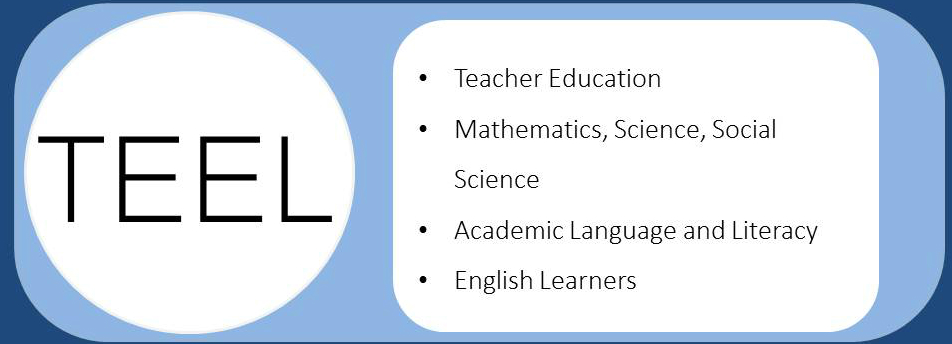TEEL focuses on two national priorities: (1) improving the preparation of teachers to work with the rapidly expanding population of ELLs; and (2) implementation of the new Common Core (CCSS) and Next Generation Science Standards (NGSS). These two agendas are synergistic. Research on effective teaching practices for ELL has demonstrated that integrating English language and literacy development in contextualized instruction in STEM subjects increases ELLs’ achievement in science, math, and academic language and literacy (Stoddart, Pinal, [date]). The relationship between science and math learning and English language and literacy development is reciprocal and synergistic. Through the contextualized and authentic use of language in scientific, mathematical, and engineering practices, students develop and practice complex language forms and functions. Simultaneously, through the use of language functions such as explanations and arguments in STEM investigations, students make sense of abstract ideas (Baquedano-López, Solís, & Kattan, 2005; Bravo & Garcia, 2004; Cervetti, Pearson, Barber, Hiebert & Bravo, 2007; Lee, Maerten-Rivera, Penfield, LeRoy, & Secada, 2008; Ovando & Combs, 2012; Reiss, 2012; Rivet & Kracjik, 2008; Rosebery & Warren, 2008; Short, Vogt & Echevarria, 2011; Solís, 2005; Stoddart et al, 2002). The fundamental relationship between the teaching of academic language and literacy and the learning of school subjects is a central tenet of both the CCSS and NGSS.
K-12 Teachers Unprepared To Teach ELLs
Currently, however, few novice or experienced teachers feel prepared to teach ELLs (Ballantyne, Sanderman, & Levy, 2008; California Legislative Analyst’s Office [LAO], 2007-2008); Gándara, Maxwell-Jolly, & Driscoll, 2005; NCES, 2001) and the majority of pre-service teacher education programs do not include explicit preparation in teaching subject matter to ELLs (Ballantyne et al, 2008; Darling-Hammond, 2006; Gándara, Maxwell-Jolly, & Driscoll, 2005; NCES, 2001; Villegas & Lucas, 2002). As a consequence, each year thousands of new teachers enter the profession unprepared to teach this rapidly growing population of K-12 students. This is problematic because for thirty years, the achievement of linguistic minority students has lagged behind that of native English speakers in math, science and literacy and they are less likely to pursue advanced degrees in STEM subjects. This bimodal pattern of K-12 and college student achievement in STEM subjects is strongly correlated with the bimodal distribution of workers in the labor force, with ELLs being overrepresented in low-skill, low-paid occupations and underrepresented in high tech and professional occupations. The challenge is to prepare teachers to effectively integrate the development of academic language and literacy into the teaching of school subjects.
Need For Empirical Research On Teacher Preparation
At the national level there have been calls from educational research associations and funding agencies for the increased use of large scale mixed methods empirical studies that provide definitive information on the efficacy and generalisability of educational interventions. In 2008, the Council of the American Educational Research Association in defining scientifically based research stated that:
The examination of causal questions requires experimental designs using random assignment or quasi-experimental or other designs that substantially reduce plausible competing explanations for the obtained results. These include, but are not limited to, longitudinal designs, case control methods, statistical matching, or time series analyses. This standard applies especially to studies evaluating the impacts of policies and programs on educational outcomes.
In 2010, a report from the Carnegie Foundation for the Advancement of Teaching emphasized the need for evidence-based solutions to problems of practice derived from rigorous and widely replicated research. However, reviews of the educational research literature demonstrate that there is very little current research that meets these criteria. For example, Sleeter (2014) found that only 1% of research on teacher education published in leading teacher education journals report the findings of large-scale mixed methods studies. In this context the work of TEEL is highly distinctive in that the research program, funded by three NSF and USDOE grants (ESTELL, SSTELLA, and ELLISA) uses a quasi-experimental, mixed-methods research design to establish causal links between pre-service teachers experience in teacher education programs, the development of their knowledge, beliefs, and practices, and the achievement of the K-12 students they teach. The TEEL research group is one of the few projects nationally or internationally currently conducting this type of teacher education research.
